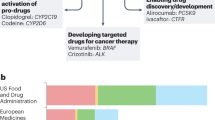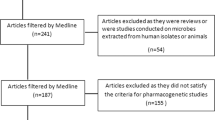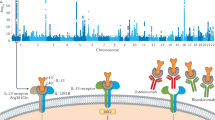Abstract
Although considerable progress has been made in basic pharmacogenetic research, less has been demonstrated in the application of pharmacogenetics (PGx)-based diagnostics to drug development and in clinical practice. There are drugs that are currently used in the clinic for which individualized therapy could be beneficial based on PGx data. However, specific, actionable recommendations on how to implement individualized therapy — particularly with respect to dosage — still have to be developed. Moreover, to apply PGx efficiently in clinical drug development, and later in drug therapy, study designs and the generation and handling of PGx data need to become more standardized. Here, we argue for the development of concise guidelines for implementation of PGx analyses in drug development and therapy.
This is a preview of subscription content, access via your institution
Access options
Subscribe to this journal
Receive 12 print issues and online access
$209.00 per year
only $17.42 per issue
Buy this article
- Purchase on Springer Link
- Instant access to full article PDF
Prices may be subject to local taxes which are calculated during checkout




Similar content being viewed by others
References
Kirchheiner, J. et al. Pharmacogenetics of antidepressants and antipsychotics: the contribution of allelic variations to the phenotype of drug response. Mol. Psychiatry 9, 442–473 (2004).
Stanulla, M. et al. Thiopurine methyltransferase (TPMT) genotype and early treatment response to mercaptopurine in childhood acute lymphoblastic leukemia. JAMA 293, 1485–1489 (2005).
Phillips, K. A., Veenstra, D. L., Oren, E., Lee, J. K. & Sadee, W. Potential role of pharmacogenomics in reducing adverse drug reactions: a systematic review. JAMA 286, 2270–2279 (2001).
Gardiner, S. J. & Begg, E. J. Pharmacogenetic testing for drug metabolizing enzymes: is it happening in practice? Pharmacogenet. Genomics 15, 365–369 (2005).
Koch, W. H. Technology platforms for pharmacogenomic diagnostic assays. Nature Rev. Drug Discov. 3, 749–761 (2004).
Wilkinson, G. R. Drug metabolism and variability among patients in drug response. N. Engl. J. Med. 352, 2211–2221 (2005).
Evans, W. E. & Relling, M. V. Moving towards individualized medicine with pharmacogenomics. Nature 429, 464–468 (2004).
Phillips, K. A. & Van Bebber, S. L. Measuring the value of pharmacogenomics. Nature Rev. Drug Discov. 4, 500–509 (2005).
Lesko, L. J. et al. Pharmacogenetics and pharmacogenomics in drug development and regulatory decision making: report of the first FDA-PWG-PhRMA-DruSafe Workshop. J. Clin. Pharmacol. 43, 342–358 (2003).
US Food and Drug Administration. Draft Guidance for Industry: Pharmacogenomics Data submission [online], <http://www.fda.gov/cber/gdlns/pharmdtasub.pdf> (2005).
Salerno, R. A. & Lesko, L. J. Pharmacogenomics in drug development and regulatory decision-making: the genomic data submission (GDS) proposal. Pharmacogenomics 5, 25–30 (2004).
Kirchheiner, J. et al. CYP2D6 and CYP2C19 genotype-based dose recommendations for antidepressants: a first step towards subpopulation-specific dosages. Acta Psychiatr. Scand. 104, 173–192 (2001).
Kirchheiner, J. & Brockmöller, J. Clinical consequences of cytochrome P450 2C9 polymorphisms. Clin. Pharmacol. Ther. 77, 1–16 (2005).
McLeod, H. L. & Siva, C. The thiopurine S-methyltransferase gene locus — implications for clinical pharmacogenomics. Pharmacogenomics 3, 89–98 (2002).
Murphy, G. M. Jr, Hollander, S. B., Rodrigues, H. E., Kremer, C. & Schatzberg, A. F. Effects of the serotonin transporter gene promoter polymorphism on mirtazapine and paroxetine efficacy and adverse events in geriatric major depression. Arch. Gen. Psychiatry 61, 1163–1169 (2004).
Zanardi, R. et al. Factors affecting fluvoxamine antidepressant activity: influence of pindolol and 5-HTTLPR in delusional and nondelusional depression. Biol. Psychiatry 50, 323–330 (2001).
Hughes, D. A. et al. Cost-effectiveness analysis of HLA B*5701 genotyping in preventing abacavir hypersensitivity. Pharmacogenetics 14, 335–342 (2004).
De Laurentiis, M. et al. Targeting HER2 as a therapeutic strategy for breast cancer: a paradigmatic shift of drug development in oncology. Ann. Oncol. 16 (Suppl. 4), iv7–iv13 (2005).
Gorre, M. E. et al. Clinical resistance to STI-571 cancer therapy caused by BCR-ABL gene mutation or amplification. Science 293, 876–880 (2001).
Kobayashi, S. et al. EGFR mutation and resistance of non-small-cell lung cancer to gefitinib. N. Engl. J. Med. 352, 786–792 (2005).
Harbour, R. & Miller, J. A new system for grading recommendations in evidence based guidelines. BMJ 323, 334–336 (2001).
Fukuda, T. et al. The impact of the CYP2D6 and CYP2C19 genotypes on venlafaxine pharmacokinetics in a Japanese population. Eur. J. Clin. Pharmacol. 56, 175–180 (2000).
Veefkind, A. H., Haffmans, P. M. & Hoencamp, E. Venlafaxine serum levels and CYP2D6 genotype. Ther. Drug Monit. 22, 202–208 (2000).
Lessard, E. et al. Influence of CYP2D6 activity on the disposition and cardiovascular toxicity of the antidepressant agent venlafaxine in humans. Pharmacogenetics 9, 435–443 (1999).
Ohno, M. et al. Slow N-acetyltransferase 2 genotype affects the incidence of isoniazid and rifampicin-induced hepatotoxicity. Int. J. Tuberc. Lung Dis. 4, 256–261 (2000).
Rothman, K. & Greenland, S. in Modern Epidemiology (Lippincott Williams and Wilkins, Philadelphia, 1998).
Patsopoulos, N. A., Analatos, A. A. & Ioannidis, J. P. Relative citation impact of various study designs in the health sciences. JAMA 293, 2362–2366 (2005).
Mueller, C. et al. Use of B-type natriuretic peptide in the evaluation and management of acute dyspnea. N. Engl. J. Med. 350, 647–654 (2004).
Dilger, K. et al. Consequences of rifampicin treatment on propafenone disposition in extensive and poor metabolizers of CYP2D6. Pharmacogenetics 9, 551–559 (1999).
Sachse, C., Brockmöller, J., Bauer, S. & Roots, I. Functional significance of a C-->A polymorphism in intron 1 of the cytochrome P450 CYP1A2 gene tested with caffeine. Br. J. Clin. Pharmacol. 47, 445–449 (1999).
John, S. et al. Whole-genome scan, in a complex disease, using 11,245 single-nucleotide polymorphisms: comparison with microsatellites. Am. J. Hum. Genet. 75, 54–64 (2004).
Brockmöller, J., Kirchheiner, J., Meisel, C. & Roots, I. Pharmacogenetic diagnostics of cytochrome P450 polymorphisms in clinical drug development and in drug treatment. Pharmacogenomics 1, 125–151 (2000).
Kinzig-Schippers, M. et al. Should we use NAT2 genotyping to personalize isoniazid doses? Antimicrob. Agents Chemother. 49, 1733–1738 (2005).
Author information
Authors and Affiliations
Corresponding author
Ethics declarations
Competing interests
The authors declare no competing financial interests.
Glossary
- ACTIONABLE RECOMMENDATION
-
An actionable recommendation in the present context is a recommendation or rule by which all physicians would make the same decision based on a given pharmacogenetic test result.
- AUC
-
Area under the concentration–time curve of a drug, usually measured in human plasma or serum.
- BIOAVAILABILITY
-
Availability of a drug at its site of action measured by AUC.
- BIOEQUIVALENCE
-
Two formulations of a given drug are considered bioequivalent if AUC, maximum blood concentrations and times of maximum blood concentrations differ by no more than 80–125%.
- CASE-CONTROL STUDY
-
A retrospective study design in which a study group suffering from a disease or particular drug response are compared by genotype with a control group. The control group is selected after the cases have been identified.
- COHORT STUDY
-
A study design in which all subjects exposed to a certain condition are studied prospectively and then compared by genotype.
- NESTED CASE-CONTROL STUDY
-
A cohort study in which not all participants are analysed but only a subgroup of cases are compared with controls drawn from the same cohort.
- PANEL STUDY
-
A study in groups (panels) pre-selected for a certain property, for example, genotype.
- PHARMACOGENETICS-BASED DIAGNOSTICS
-
Diagnosis of genetic variants that facilitates the optimization of drug therapy. Also encompasses genetic analysis of disease, for example, the genomes of tumours or of infectious agents in an individual patient.
- PHARMACOKINETIC–PHARMACODYNAMIC RELATIONSHIP
-
Quantitative relationship between blood and tissue concentrations of the drug (pharmacokinetics) and the effects (pharmacodynamics) of a drug.
- STEADY-STATE CONCENTRATION
-
Drug concentrations during long-term therapy.
- STRATIFICATION
-
Separate and joint analysis of subgroups (the strata) of a study concerning the parameters of interest, for example, a specific genotype.
Rights and permissions
About this article
Cite this article
Kirchheiner, J., Fuhr, U. & Brockmöller, J. Pharmacogenetics-based therapeutic recommendations — ready for clinical practice?. Nat Rev Drug Discov 4, 639–647 (2005). https://doi.org/10.1038/nrd1801
Issue Date:
DOI: https://doi.org/10.1038/nrd1801
This article is cited by
-
Recent Progress in Pharmacogenomics of Antipsychotic Drug Response
Current Psychiatry Reports (2018)
-
The GRM7 gene, early response to risperidone, and schizophrenia: a genome-wide association study and a confirmatory pharmacogenetic analysis
The Pharmacogenomics Journal (2017)
-
Pharmacogenomics of Antipsychotic Drugs
Current Treatment Options in Psychiatry (2017)
-
Medical education in pharmacogenomics—results from a survey on pharmacogenetic knowledge in healthcare professionals within the European pharmacogenomics clinical implementation project Ubiquitous Pharmacogenomics (U-PGx)
European Journal of Clinical Pharmacology (2017)
-
The CYP4502D6 *4 and *6 alleles are the molecular genetic markers for drug response: implications in colchicine non-responder FMF patients
European Journal of Drug Metabolism and Pharmacokinetics (2016)



